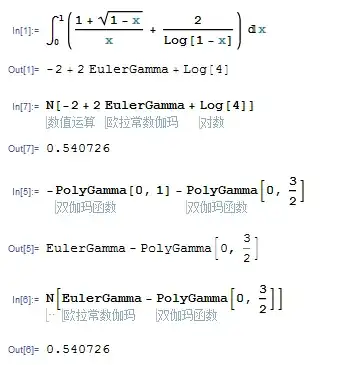$\newcommand{\bbx}[1]{\,\bbox[8px,border:1px groove navy]{\displaystyle{#1}}\,}
\newcommand{\braces}[1]{\left\lbrace\,{#1}\,\right\rbrace}
\newcommand{\bracks}[1]{\left\lbrack\,{#1}\,\right\rbrack}
\newcommand{\dd}{\mathrm{d}}
\newcommand{\ds}[1]{\displaystyle{#1}}
\newcommand{\expo}[1]{\,\mathrm{e}^{#1}\,}
\newcommand{\ic}{\mathrm{i}}
\newcommand{\mc}[1]{\mathcal{#1}}
\newcommand{\mrm}[1]{\mathrm{#1}}
\newcommand{\pars}[1]{\left(\,{#1}\,\right)}
\newcommand{\partiald}[3][]{\frac{\partial^{#1} #2}{\partial #3^{#1}}}
\newcommand{\root}[2][]{\,\sqrt[#1]{\,{#2}\,}\,}
\newcommand{\totald}[3][]{\frac{\mathrm{d}^{#1} #2}{\mathrm{d} #3^{#1}}}
\newcommand{\verts}[1]{\left\vert\,{#1}\,\right\vert}$
\begin{align}
&\int_{0}^{1}\bracks{{1 + \root{1 - x} \over x} + {2 \over \ln\pars{1 - x}}}
\,\dd x
\,\,\,\stackrel{\root{1 - x}\ \mapsto\ x}{=}\,\,\,
2\int_{0}^{1}{x \over 1 - x}\
\overbrace{\bracks{1 + {1 - x \over \ln\pars{x}}}}
^{\ds{\int_{0}^{1}\pars{1 - x^{t}}\,\dd t}}\ \,\dd x
\\[5mm] = &\
2\int_{0}^{1}\int_{0}^{1}{x - x^{t + 1} \over 1 - x}\,\dd x\,\dd t =
2\int_{0}^{1}\pars{\int_{0}^{1}{1 - x^{t + 1} \over 1 - x}\,\dd x - \int_{0}^{1}\dd x}\dd t
\\[5mm] = &\
2\int_{0}^{1}\braces{\vphantom{\Large A}\bracks{\vphantom{\large A} \Psi\pars{t + 2} + \gamma} - 1}\,\dd t\qquad
\pars{~\Psi:\ Digamma\ Function~}\label{1}\tag{1}
\\[5mm] = &\
2\bracks{\ln\pars{\Gamma\pars{3} \over \Gamma\pars{2}} + \gamma - 1}\qquad
\pars{~\Gamma:\ Gamma\ Function~}
\\[5mm] = &\ \bbx{\ds{2\bracks{\vphantom{\large A}\gamma + \ln\pars{2} - 1}}}
\end{align}
In \eqref{1}, I used the well known identity $\ds{\mathbf{6.3.22}}$ from
A & S Table.
